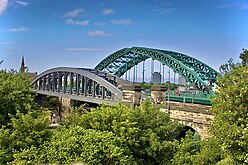
Back Sunderland AN سندرلاند Arabic سندرلاند ARZ Sunderland AST Sanderlend Azerbaijani ساندرلند AZB Sunderland BAN Сандэрленд Byelorussian Сандэрлэнд BE-X-OLD Съндърланд Bulgarian
| Sunderland | |
|---|---|
| City | |
| |
Location within Tyne and Wear | |
| Population | 168,277 (2021 Census)[1] |
| Demonym | Mackem |
| OS grid reference | NZ395575 |
| • London | 240 miles (390 km) SSE |
| Metropolitan borough | |
| Metropolitan county | |
| Region | |
| Country | England |
| Sovereign state | United Kingdom |
| Post town | SUNDERLAND |
| Postcode district | SR1–SR6 |
| Dialling code | 0191 |
| Police | Northumbria |
| Fire | Tyne and Wear |
| Ambulance | North East |
| UK Parliament | |
| Website | sunderland |
Sunderland (/ˈsʌndərlənd/ ⓘ) is a port city[a] in Tyne and Wear, England. It is a port at the mouth of the River Wear on the North Sea, approximately 10 miles (16 km) south-east of Newcastle upon Tyne. The built-up area had a population of 168,277 at the 2021 census, making it the second largest settlement in North East England after Newcastle. It is the administrative centre of the metropolitan borough of the same name.
Sunderland was once known as 'the largest shipbuilding town in the world' and once made a quarter of all of the world's ships from its famous yards, which date back to 1346 on the River Wear.
The centre of the modern city is an amalgamation of three settlements founded in the Anglo-Saxon era: Monkwearmouth, on the north bank of the Wear, and Sunderland and Bishopwearmouth on the south bank. Monkwearmouth contains St Peter's Church, which was founded in 674 and formed part of Monkwearmouth–Jarrow Abbey, a significant centre of learning in the seventh and eighth centuries. Sunderland was a fishing settlement and later a port, being granted a town charter in 1179. The city traded in coal and salt, also developing shipbuilding industry in the fourteenth century and glassmaking industry in the seventeenth century. Following the decline of its traditional industries in the late 20th century, the area became an automotive building centre. In 1992, the borough of Sunderland was granted city status. Sunderland is historically part of County Durham, being incorporated to the ceremonial county of Tyne and Wear in 1974.
Locals are sometimes known as Mackems, a term which came into common use in the 1970s. Its use and acceptance by residents, particularly among the older generations, is not universal.[2][3] The term is also applied to the Sunderland dialect, which shares similarities with the other North East England dialects.
- ^ "North East England (United Kingdom): Counties and Unitary Districts & Settlements - Population Statistics, Charts and Map". www.citypopulation.de.
- ^ "Sunderland Mackem Origin". englandsnortheast.co.uk. 2016. Retrieved 19 August 2017.
- ^ "Mackem". Seagull City. 2017. Retrieved 19 August 2017.
Cite error: There are <ref group=lower-alpha> tags or {{efn}} templates on this page, but the references will not show without a {{reflist|group=lower-alpha}} template or {{notelist}} template (see the help page).





